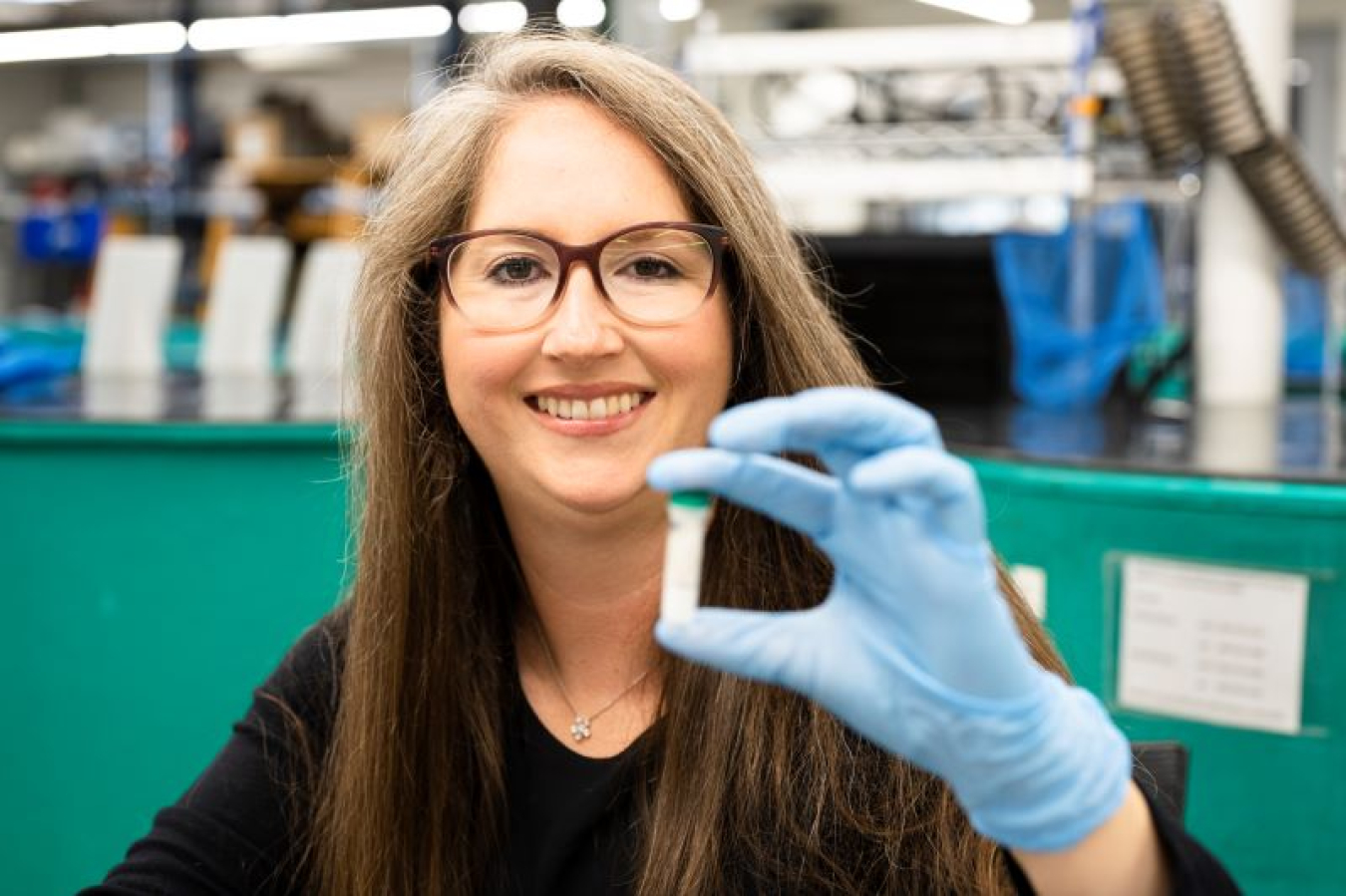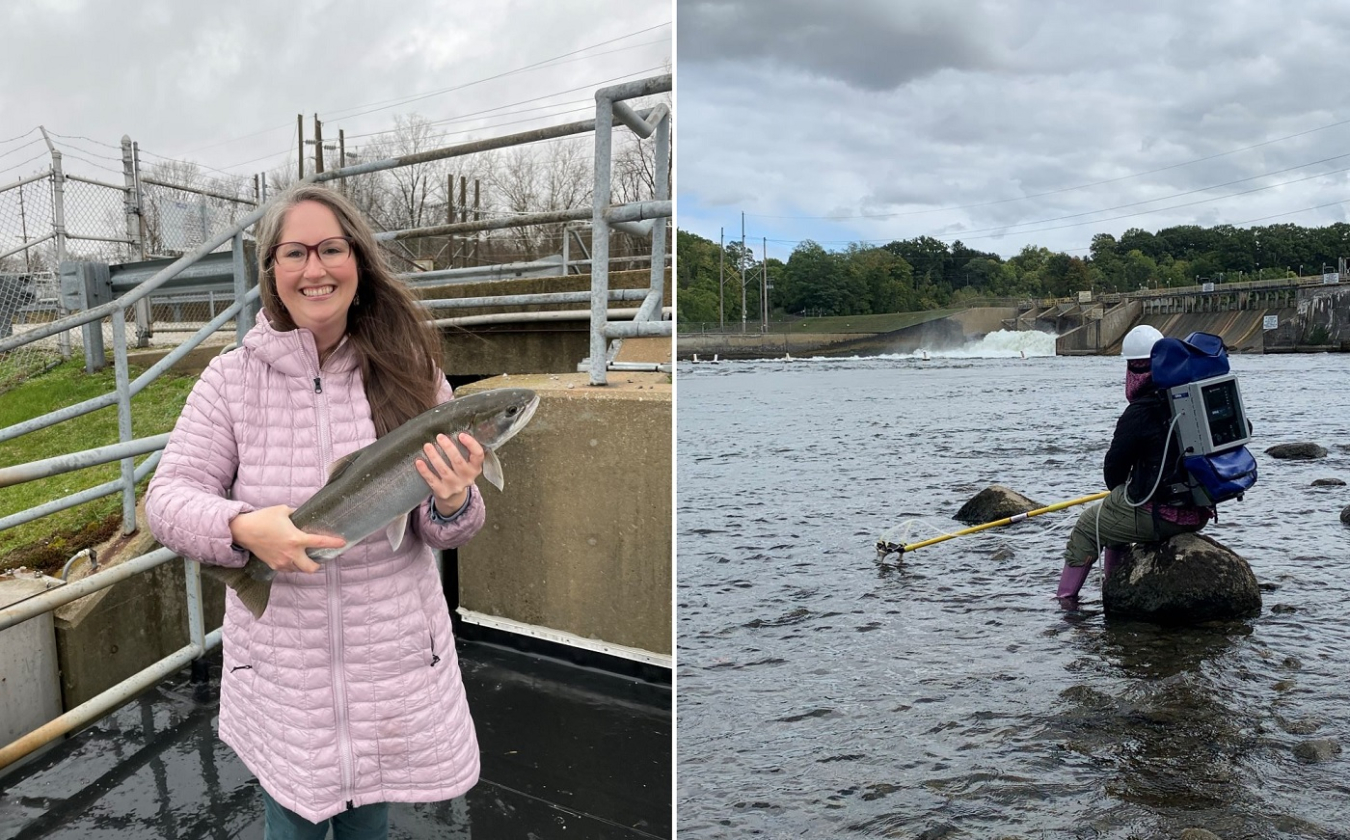Learn how Kristine Moody, a molecular ecologist at Oak Ridge National Laboratory, developed an intense curiosity about aquatic creatures, leading to a career in water power.
Water Power Technologies Office
November 13, 2024Kristine Moody stood ribs-deep in a snow-cold Hawaiian stream. Water dripped from her hair and cheeks onto her neoprene wet suit. She pushed her snorkel up onto her forehead, took a few above-water breaths, and grinned. Some people go to Hawaii to sunbathe and slurp tropical drinks. But for Moody, searching for a slimy, camouflaged fish in chilly water—that was paradise.
“I refer to myself as an aquatic mammal, not a terrestrial mammal. I am most at home in the water,” said Moody, a molecular ecologist at Oak Ridge National Laboratory (ORNL).
Moody grew up snorkeling, sailing, and swimming in warmer Floridian waters and developed an intense curiosity about aquatic creatures. The feeling was mutual: “My family always jokes that I’m like Doctor Dolittle. Animals always seem to seek me out,” Moody said.

Now, Moody has dedicated her career to seeking them out. In those frigid Hawaiian waters, she was searching for waterfall-climbing gobies to study why these intrepid fish traverse seas and steep streams to survive. Today, at ORNL, she tracks even more fish species using something called environmental DNA and RNA (or eDNA and eRNA, for short).
When a creature like a trout, eel, or mussel—or even a beaver, groundhog, cow, pig, or human—touches water, it leaves behind traces of its genetic material, namely, its DNA and RNA. With just a small water sample, Moody can use these markers to track which species are present in a specific waterway, estimate how many passed by within the last hour, and potentially learn their age, sex, and much, much more.
“There’s a lot more information in the water than we give it credit for,” Moody said. “We’re taking new approaches that nobody’s really doing yet, like using eRNA in real-world settings. So, we’re on that bleeding edge.”
Hydropower operators are paying attention. Because eDNA and eRNA allow Moody and others to track fish population health without touching a single fin, hydropower operators can use this method to monitor their impact on local ecosystems. And these noninvasive techniques have proven to be just as accurate as and more efficient, affordable, and safer than their conventional manual fish counting systems.
“It’s our responsibility to make sure we understand what the impacts are and how to best mitigate them and come up with solutions that are going to be either preventative or reconstructive,” Moody said.
In this Q&A, Moody shared why she could never be a veterinarian, how fruit flies led her to gobies, and why a robot called “Edna” could help hydropower facilities collect critical fish data even in remote, hard-to-reach waterways.
_
Did you always know you’d end up in a career in science, technology, engineering, and mathematics (STEM)?
My friends and I were super chemistry nerds. In college, we had a white board that we wrote our formulas on and carried around. So yes, I always knew I would stay in STEM, which is very different from anyone in my family. I was raised by a single mom, and she went to college but never graduated. This was a new world.
What was it like not to have a model to follow?
I never really thought about those things. I was just like, ’I’m going to go to a great school and see where the path takes me.’ I always say my scientific career has been serendipitous—I happened to take a genetics class in undergrad that just clicked and was taught by an amazing professor, Marta Wayne. She introduced me to Margaret Ptacek at Clemson University because she thought her lab would be a great fit for graduate school. And it was. From there on, it all just seemed to fall into place.

But my path is different because none of my family is in science at all. When I was in graduate school, I said to my mom, ‘I’m in lab. I’ve got to go clone fish.’ And she was so excited and asked, ‘Oh, my gosh. Are you making a Dolly?’ Like Dolly, the cloned sheep. I said, ‘No. I’m making more copies of a specific gene.’ And she was like, ‘Well, wouldn't it be cooler if you made fish?’ Well, yes. So, there’s always a lot of explaining. But my family loves to learn about what I do, and I’m so grateful to have their support every step of the way, even if I’m not making more fish.
Were there any other obstacles or barriers that you had to overcome to build your career path?
At first, I thought I was going to be a veterinarian, but I quickly realized that I could not put peoples’ pets to sleep. That was too emotionally taxing. And my undergrad career at the University of Florida wasn’t my strongest point, but I really enjoyed genetics. I was fortunate enough to learn from Dr. Wayne, who took an interest in her students as people, and we had some shared life experiences. She asked if I wanted to volunteer in her lab, and I wound up working in her quantitative genetics fruit fly lab for almost 4 years. That time was transformative, and I credit her with keeping me on a scientific path.
How did you end up at ORNL?
I studied endemic Hawaiian waterfall-climbing gobies for almost 13 years before coming to ORNL, both as a graduate student at Clemson University with Dr. Ptacek and then a postdoc at Tulane University and the University of Tennessee with Dr. Mike Blum. I’ve taken my conservation and genetics background and merged it into the water power field to understand how hydropower impacts our aquatic environments and the organisms that live there. We’re coming up with ways to protect the animals we study using noninvasive tools. That’s why using environmental DNA and RNA from a water sample is so interesting. There’s a whole world of information in there. How do we make sense of it?
How do you do that? Are there fish cells floating in the water?
Yes, there are, but it’s not just fish and not just in water; eDNA and eRNA are in the air and soil too. You can get pollinator DNA out of honey to tell which flowers the bees have visited. We’re primarily interested in fish, but we can ask questions about freshwater mussels, aquatic plants, or terrestrial processes, like watershed runoff, land use changes, and more.
What problems are you trying to solve with these noninvasive monitoring techniques?
Our goal is to figure out what information we can draw from a water sample. Methods involving eDNA have only been around for about 12 years. We’re really good at using it to say which species are present and getting better at determining the number of individuals. An important question we are working on—and this hasn’t really been done before—is: Can we use eDNA to determine how old a fish is or how old the entire fish community is? If you have lots of old, post-reproductive-age individuals and there’s some climatic change or disturbance, is that population vulnerable and at high risk of going extinct? Or do you have a lot of young, reproductive-age individuals and they're starting to expand and maybe invade? You can potentially gather that information from water samples. And there’s a lot more information and questions we could answer by using eRNA in addition to eDNA.
Why? What’s the difference between eRNA and eDNA?
DNA can stay in the environment for a really long time. Scientists can take core samples from the Arctic and detect species from hundreds of thousands of years ago. But RNA breaks down really rapidly. After about 12 hours, it’s depleted almost down to nothing, so you can get a really good time shot of what’s in the water in that immediate moment. In fish ladders—structures that allow fish to move past hydropower facilities—we’re interested in what and how many species are passing through. That means eDNA can tell us who, and eRNA can tell us how many at that point in time, which is quite novel. But there’s so much information in water that we just don’t know yet.
What’s next?
For one of our projects funded through the Water Power Technologies Office, we’re building a robot we call eDNA-bot (pronounced ‘Edna Bot’). Yes, it’s a she. The goal is to have her be deployable across the world to collect water, process and sequence it, tell you what’s in there and how many, and send you the data. Users will be able to program eDNA-bot on what to do, but she also has autonomous properties. She can say, ‘We’re flooding. I’m going to pull myself back in, go into low power mode, and hunker down.’ Then, when the environment is stable again, she’ll go back out and sample.

What does eDNA-bot look like?
Right now, parts on a desk. We’re aiming for the size of your average suitcase so anybody could pick her up and take her into the field. We want her to be easy to use and affordable. There are other products out there, but they are quite expensive and very heavy (hundreds of pounds). That’s not a commercially viable product if you want to go to a remote region, like Alaska, or deep in the Amazon. But with eDNA-bot, the goal is to just throw her in and see what comes out. We’re going for a device that’s deployable around the globe for broad use.
So, could hydropower facilities use this to easily monitor their facilities’ impact on fish populations?
That’s the goal. We’re making eDNA-bot fit for both conventional hydropower and marine energy operations. So, when hydropower facilities are going up for relicensing and they have to know what’s coming through their fish passage, they could get an eDNA-bot and save time and cost, keep their personnel safe, and give them real-time data. For marine energy system deployments, eDNA-bot can gather biodiversity data to identify appropriate locations and track post-deployment changes. With eDNA-bot, there’s no lag between collection and knowing what’s out there.
In an ideal world, what would you most hope to accomplish throughout your career?
I just want to have a real-world impact. With climate change and the transition from fossil fuels to clean energy, we need to know what's happening in real time in these ecosystems that are being impacted and how we best mitigate those impacts to protect biodiversity.
What advice would you give to the next generation of folks who might want to work in renewable energy or even wildlife monitoring?
Figure out what you like and what you don’t like and pursue what you like. I know that sounds vague and hand-washy, but it really matters. If you don't enjoy what you're doing, then you're not going to push yourself to do the best. And you don’t have to know in high school or undergrad what you want to do when you grow up. I had no clue that my interests in genetics and conservation would lead to a career in water power. Yes, I'm a scientist, and I’m still trying to figure out what I want to do when I grow up.
Catch up on WPTO's other Ripple Effect profiles and the Office of Energy Efficiency and Renewable Energy's Clean Energy Champions.
And stay in the know with WPTO! Receive the latest information on funding opportunities, events, and other news by subscribing to the Hydro Headlines and Water Column newsletters, as well as the comprehensive Water Wire newsletter.

